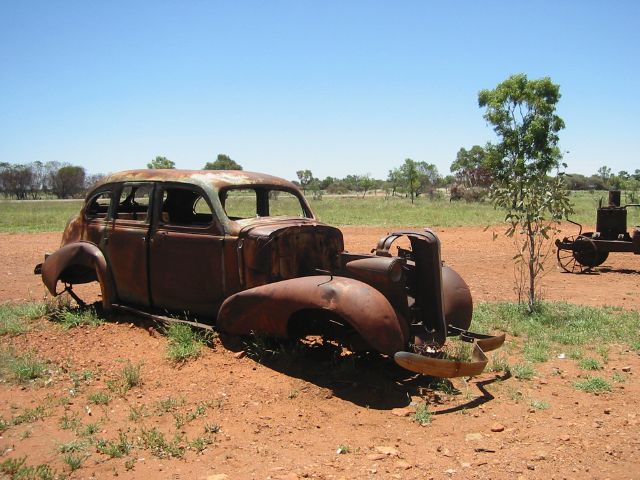 The board of General Motors has expressed support for Rick Wagoner, the ailing auto giant's embattled chief executive, as it approved shedding yet another profitable arm to stay afloat -- the General Motors Acceptance Corporation -- for a cool $7.4 billion.
The board of General Motors has expressed support for Rick Wagoner, the ailing auto giant's embattled chief executive, as it approved shedding yet another profitable arm to stay afloat -- the General Motors Acceptance Corporation -- for a cool $7.4 billion.Auto analysts said that the board's first public comment on Wagoner since a spate of bad news did not constitute an unconditional backing. Good damned thing!
Because there were a lot of technical problems out in the old blogosphere on March 31, I'm republishing my own take on the sorry state of The General from that date.
* * * * *
I trace the fact that GM is nearly as clueless today as it was in 1976 back to 1992, when Rick Wagoner, then GM’s 39-year-old chief financial officer, was promoted and given orders to shake up the moribund giant.
I believe that the only way that GM can be revived is for Wagoner, GM's president and CEO, to be fired. Now.
* * * * *
The 1976 Accord had just everything that the GM cars of that era didn’t.
It was attractive, albeit in a cute sort of way. It was larger on the inside than it appeared from the outside, not the other way around. It had a rear hatch that opened to a collapsible back seat, offering lots of storage space. It handled well, had some oomph and was economical, which was no small thing arriving as it did between the twin 1970s oil crises. A practical friend who had owned GM cars forever bought a silver '76 Accord and was hooked. I drove it and was hooked, too.
GM’s response to the Accord and successive waves of hot selling offerings from
The General’s fortunes briefly improved after Wagoner took over and GM's share price soared to a record $90. But beneath the gloss the same fundamental problems persisted, eating into the huge corporation like rust spreading through the underbody of a Cadillac Coupe de Ville.
These problems included overcapacity – too many assembly plants and not enough orders -- and except for 1998, when there was a seven-week strike, sweetheart contracts with the United Auto Workers union.
But the biggest problem was that Wagoner’s GM was coasting along with that same tired product line as much of the rest of the automotive world was stealing a march on it with attractive and innovative products.
In 1992, the year Wagoner took over, GM sold 35 percent of all cars sold in the
The question is not whether
* * * * *
Hindsight being what it is, it’s easy now to see that Wagoner was the wrong choice to turn GM around. Wall Street knows that. The car dudes who write for Motor Trend and Automobile know that. Consumers know that. Wagoner and the GM board just happen to be the last people to know that.
Wagoner came up through GM’s financial division rather than manufacturing or sales, which may explain why he has been slow to recognize virtually every major automotive trend that has occurred on his watch.
These trends include minivans, smaller SUVs (Wagoner bought the Hummer brand just as the mega-SUV bubble was bursting) and an increased environmental awareness. GM has been ridiculously slow to embrace now popular gas-electric hybrid vehicles. It has no hybrids in showrooms today, while Toyota-Lexus has 12 models, including the Lexus GS450h, a $70,000 green sports luxury machine. Toyota-Lexus will soon have 20.
GM has survived because it still makes a heck of a lot of cars -- and trucks. It just doesn’t make money. (Its ossified dealer network is in even worse shape than the mother ship, but that's another story.)
There have been successes on Wagoner's watch, but I can count only three of consequence.
He has cut costs and manufacturing capacity. Whoopie! He also has encouraged the near-death Cadillac division to shed its Geritol image. It now caters to the Led Zeppelin crowd and offers a line of trendy and well-made models, which while not my cup of tea, show that there’s life yet in the General.
But Cadillac is a niche brand and GM has yet to offer a mainstream success remotely approaching the VW Passat or Toyota Camry, which is the best selling car in
No, make that only two successes on Wagoner's watch.
After successfully nurturing Saturn as the un-GM brand, Wagoner has allowed the once innovative spinoff to be dumbed down into the rest of the corporation. Saturn sales have tanked.
At this point, it's not a matter of General Motors emerging from its long self-inflicted nightmare smaller and leaner. It's a matter of surviving, which makes bankruptcy actually look pretty good since Wagoner is pinning GM's hopes on, of all things, a new line of big SUVs like the Cadillac Escalade and ChevyTahoe.
Wagoner has had 14 years to fix GM’s problems. He has only added to them, and the proof is that it still makes an enormous amount of crap.
It’s time to go, Rick. And don’t let the door hit you in the ass on the way out.
Oh, by the way, GM’s share price closed at $22.75 yesterday.
No comments:
Post a Comment